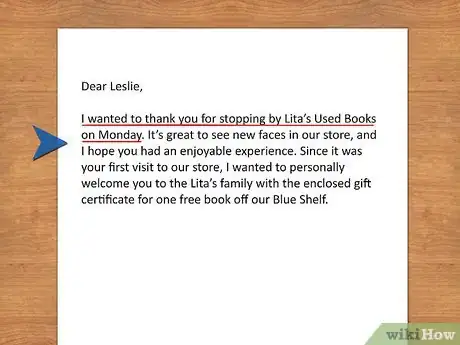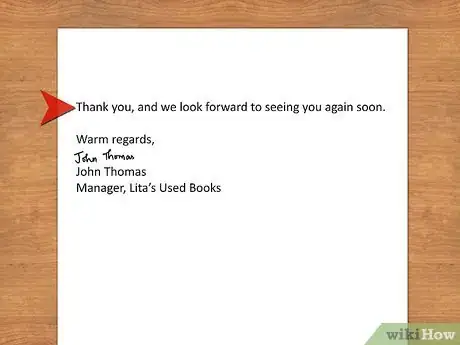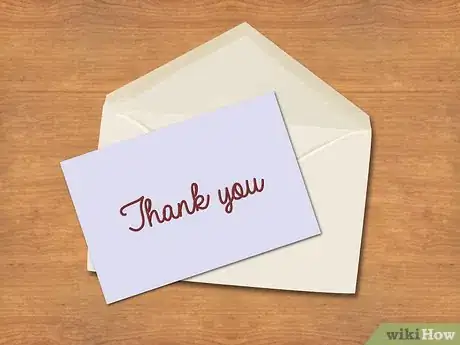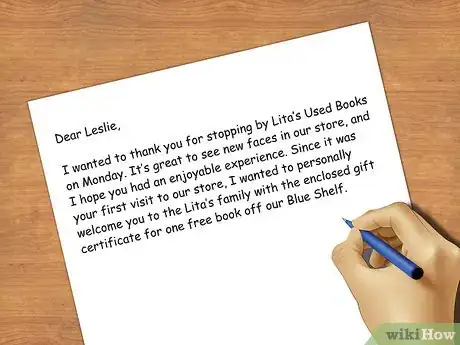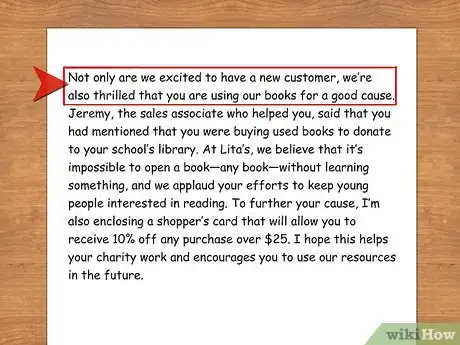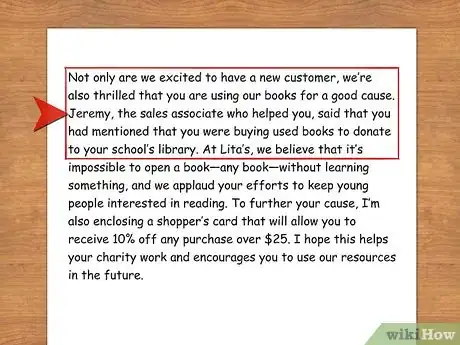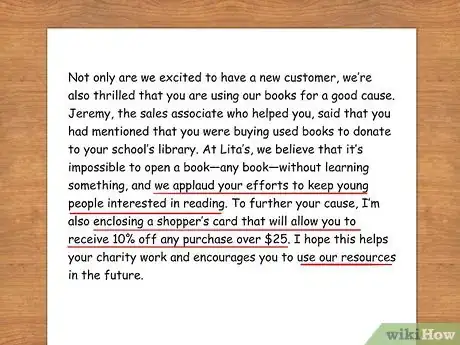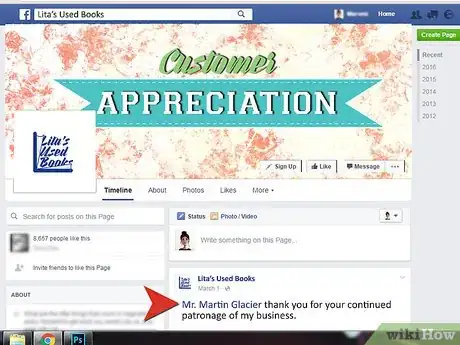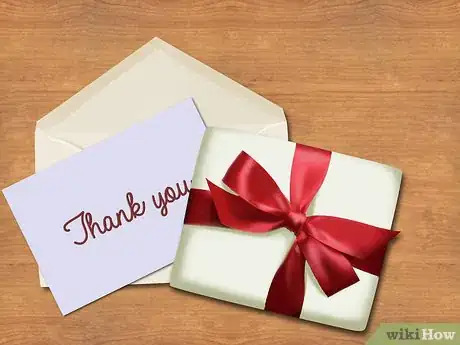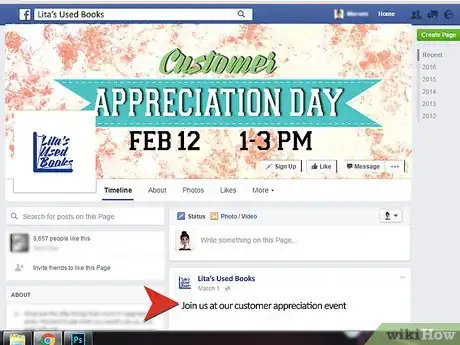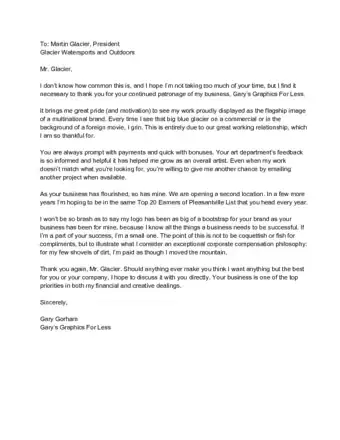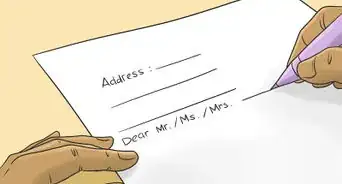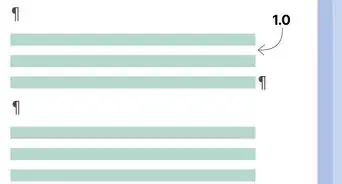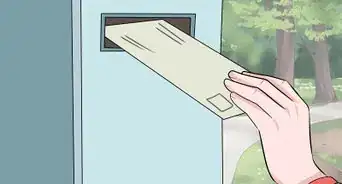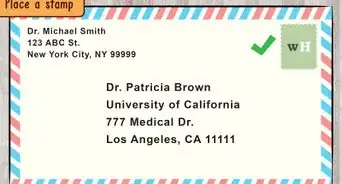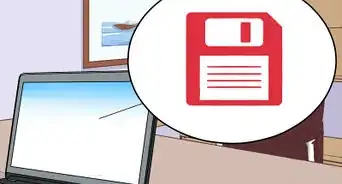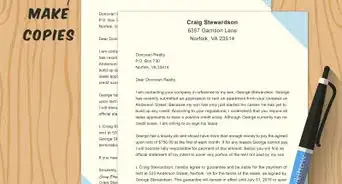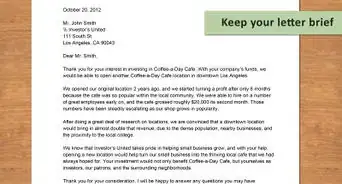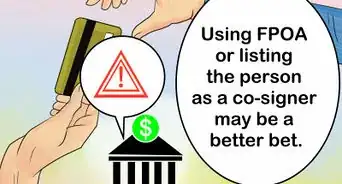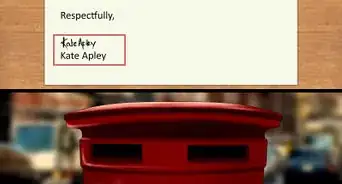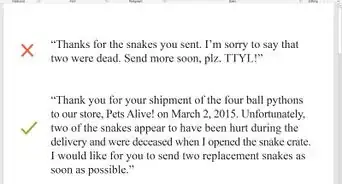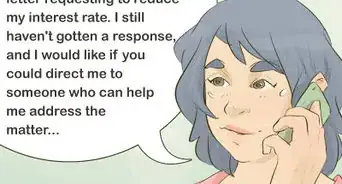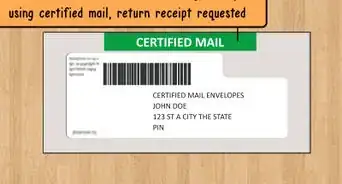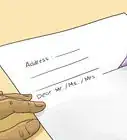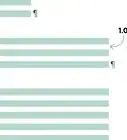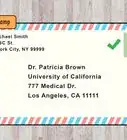This article was co-authored by John Strasser. John Strasser is a Certified Master Insight Coach and Master Insight Coaching Instructor at The Insight Coaching Community. With more than seven years of experience, John specializes in helping others work in the life coaching space and develop successful coaching businesses. John holds a BA in South Asian Religions from The University of South Florida and an MA in Buddhism and Hinduism from Columbia University. He has also studied Leadership Coaching at Harvard University.
There are 12 references cited in this article, which can be found at the bottom of the page.
This article has been viewed 220,618 times.
A customer appreciation letter is a type of business letter that a company writes to show gratitude to a customer for various reasons (e.g. being a first-time customer, a loyal customer, etc.). This letter is a great way to build and keep positive rapport with customers. Showing your customers that you appreciate them helps you keep the customers you already have and generate new business through customer referrals. Creating a pleasant customer experience is the key to a successful business.
Steps
Crafting Your Letter
-
1Address the customer by name. Begin your letter with a greeting that includes the customer's name. Make sure the customer's name is spelled correctly. The letter will lose some sincerity if the customer's name is spelled wrong.
- Start the letter by saying "Dear" followed by the customer's first name.[1]
- If you are trying to be informal you can start the letter by saying "Hi" or "Hey" followed by the customer's first name.
-
2Express the reason for appreciation. Use the specifics of your experience with them and how that experience was positive for the business.[2] Are you thanking the customer for his or her first purchase? Did the customer leave a positive review of your business online? Did the customer refer a friend to your business? Did you have nice interaction with the customer in your store? Whatever the customer did, make sure you include it in your letter.[3]
- Being specific about the reason you appreciate the customer lets the customer know that you are really paying attention and focusing on him or her.
- Always thank the customer genuinely for their business and support as well.
- If you are writing to a loyal customer, you may say, "Thank you for being a loyal customer and supporting my business for many years."
- If you are thanking a new customer, you may say, "Thanks you for trying out our _____. We love when new customers give us a shot."
Advertisement -
3Make reference to future interactions. Let the customer know that you are looking forward to seeing them again or serving any of their future needs.[4] Your letter is a genuine show of your appreciation, but it is also a marketing tool to get repeat business. If you plan to contact the customer at a specific time, include that in the letter as well.
- Mention future interactions in the closing sentence or paragraph.
- As an incentive to have a future interaction with a customer you can include some type of incentive in your appreciation letter like a coupon or gift card.
- You may say, "We look forward to seeing you again" or "I hope you to see you during the sale we are having next week."
-
4End the letter with a personal sign off. If you were writing a business letter, you may end the letter by saying "Sincerely" or "Best Regards." Remember that an appreciation letter is more personal. Choose a sign off such as "Warm Regards," "Thanks so much," or "All the best."[5]
- Carefully proofread your letter to make sure that it does not contain any errors.
- Always write your name after the sign off.
Making the Letter More Personal
-
1Send the letter unexpectedly. A letter out of the blue can be a nice surprise for a customer. Your can send a letter marking the customer's anniversary with your company, after a certain number of purchases, or just for no reason at all. Random appreciation letters build your brand and are a way to keep your business on the mind of customers.[6]
- Unusual holidays such as "National Napping Day" or "National Pi Day" are opportunities to have fun with your customers and send a letter.[7]
- Unexpected letters can be short and simply say something like "We just wanted you to know how much we appreciate you/your business."
-
2Hand-write the letter. A handwritten letter shows a greater appreciation than an email or typed letter. Most individuals, let alone companies, do not hand write letters anymore. A hand written letter will set you apart from other businesses.[8]
- If you are unable to write the entire letter, take the time to sign your name at the bottom of the note for a personalized touch.
- If you are writing the letter on behalf of a position holding member of your company, like the President or CEO, have them sign the letter in place of yourself.
-
3Be sincere. Make sure you're writing in a style that is truthful, professional and warm. Overdoing praise can seem insincere. You want the letter to express honest gratitude in a professional manner. Your customer will be able to tell if you are being genuine. If you overdo it, you may actually rub your customer the wrong way.[9]
- You never want your customer to feel as if they are receiving a generic letter that was sent to all of the other customers.[10]
- Your letter may differ based on your relationship with the customer. The letter to a loyal customer of 5 years may differ from the letter to a new customer.
-
4Use a friendly tone. Write the letter in the same voice that you speak. If the letter sounds too formal, it can sound cold and business-like. Use contractions instead of writing out words. For example, say "I'd" instead of "I would" or "don't" instead of "do not."[11]
- Even though you are writing how you would speak, use proper grammar and punctuation.
- Read your letter out loud once you are done writing. If it sounds like you are talking to a friend, you are on the right track.
-
5Use personal pronouns. Use pronouns such as "I," "we," and "you" in your letter and write in an active voice.[12] In active voice, the subject of the sentence performs the action. You would say, "We will send you more information about our customer rewards program," instead of "Information about the customer rewards program will be sent to you."
- The combination of personal pronouns and active voice helps the letter sound friendlier.
- Your letter will also be easier for customers to read if you use active voice. Writing in passive voice requires you to use more words to get your point across.[13]
Using Other Methods to Show Appreciation
-
1Acknowledge the customer on social media. You may interact with your customers on different social media platforms. Show your appreciation by thanking a customer on Twitter or Facebook.[14] If your customer interacts with you regularly on social media, you can be sure that they will see what you have said.[15]
- Social media gives you an opportunity to publicly show appreciation for your customers.
- If you use Twitter, some companies allow you to tweet gift cards to other Twitter users.
-
2Send a small gift. A small gift can have a positive impact on your customers.[16] The item can be a product associated with your brand, unique to where the company is located, a free gift with a purchase, or even access to special content on your website. Cookies are also a great way to thank your customers.[17]
- For example, if your city is known for its barbecue, you could send a small jar of barbecue sauce from a local restaurant.
- You could also send a gift for your customer's birthday or anniversary with your business.
-
3Have a customer appreciation event. A customer appreciation event shows your customers that you are willing to go the extra mile to acknowledge them. Your event could include giveaways, discounted merchandise, free shipping on online orders, or a free event at your store. Promote your event using social media or an e-newsletter that you send to you customers.[18]
Sample Letters
References
- ↑ http://www.businesswritingblog.com/business_writing/2006/11/thanksgiving_th.html
- ↑ https://www.shopify.com/blog/9696870-6-creative-ways-to-surprise-and-delight-your-customers
- ↑ John Strasser. Certified Master Insight Coach. Expert Interview. 15 October 2021.
- ↑ John Strasser. Certified Master Insight Coach. Expert Interview. 15 October 2021.
- ↑ http://www.forbes.com/sites/susanadams/2013/09/27/57-ways-to-sign-off-on-an-email/#31dea3174faa
- ↑ http://marketingland.com/how-to-optimize-your-customer-thank-you-66297
- ↑ http://www.verticalresponse.com/blog/5-easy-affordable-ways-show-customer-appreciation/
- ↑ http://www.entrepreneur.com/slideshow/225025
- ↑ http://www.entrepreneur.com/slideshow/225025
- ↑ http://www.entrepreneur.com/slideshow/225025
- ↑ http://writing-skills.com/how-to-write-to-happy-customers
- ↑ http://writing-skills.com/how-to-write-to-happy-customers
- ↑ https://webapps.towson.edu/ows/activepass.htm
- ↑ http://www.entrepreneur.com/slideshow/225025
- ↑ https://www.americanexpress.com/us/small-business/openforum/articles/12-ways-to-thank-your-customers-without-breaking-the-bank/
- ↑ John Strasser. Certified Master Insight Coach. Expert Interview. 15 October 2021.
- ↑ https://www.business2community.com/small-business/7-customer-appreciation-ideas-small-business-01081023#zZXAO2KeEjQUq8Jp.97
- ↑ http://www.entrepreneur.com/article/205184
- ↑ https://www.shopify.com/blog/9696870-6-creative-ways-to-surprise-and-delight-your-customers
- ↑ http://www.entrepreneur.com/article/205184
- ↑ http://www.verticalresponse.com/blog/5-easy-affordable-ways-show-customer-appreciation/

